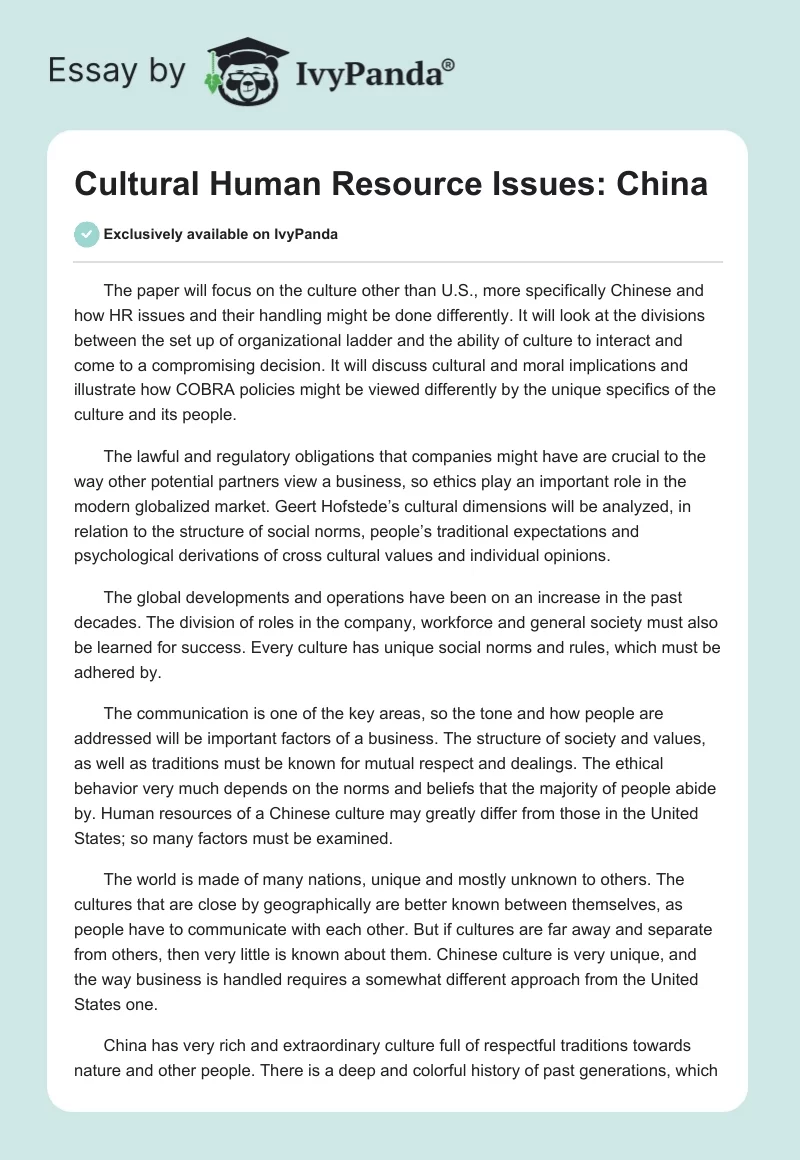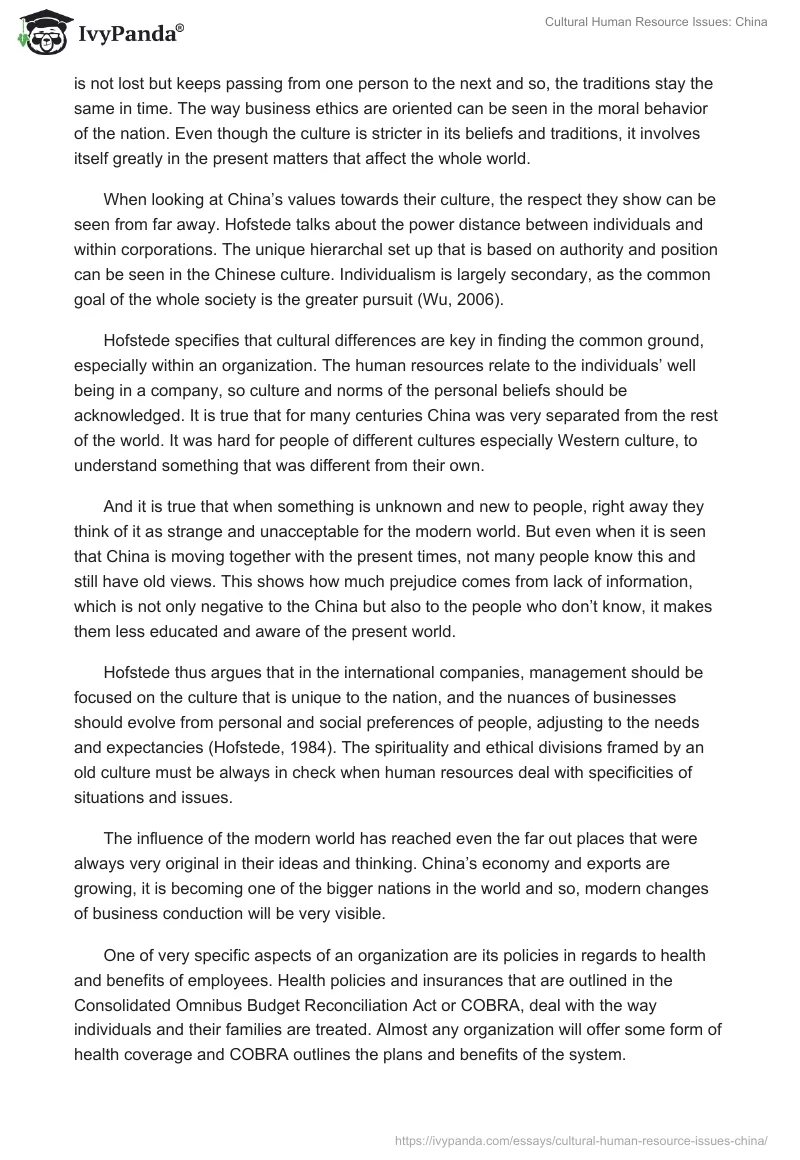The paper will focus on the culture other than U.S., more specifically Chinese and how HR issues and their handling might be done differently. It will look at the divisions between the set up of organizational ladder and the ability of culture to interact and come to a compromising decision. It will discuss cultural and moral implications and illustrate how COBRA policies might be viewed differently by the unique specifics of the culture and its people.
The lawful and regulatory obligations that companies might have are crucial to the way other potential partners view a business, so ethics play an important role in the modern globalized market. Geert Hofstede’s cultural dimensions will be analyzed, in relation to the structure of social norms, people’s traditional expectations and psychological derivations of cross cultural values and individual opinions.
The global developments and operations have been on an increase in the past decades. The division of roles in the company, workforce and general society must also be learned for success. Every culture has unique social norms and rules, which must be adhered by.
The communication is one of the key areas, so the tone and how people are addressed will be important factors of a business. The structure of society and values, as well as traditions must be known for mutual respect and dealings. The ethical behavior very much depends on the norms and beliefs that the majority of people abide by. Human resources of a Chinese culture may greatly differ from those in the United States; so many factors must be examined.
The world is made of many nations, unique and mostly unknown to others. The cultures that are close by geographically are better known between themselves, as people have to communicate with each other. But if cultures are far away and separate from others, then very little is known about them. Chinese culture is very unique, and the way business is handled requires a somewhat different approach from the United States one.
China has very rich and extraordinary culture full of respectful traditions towards nature and other people. There is a deep and colorful history of past generations, which is not lost but keeps passing from one person to the next and so, the traditions stay the same in time. The way business ethics are oriented can be seen in the moral behavior of the nation. Even though the culture is stricter in its beliefs and traditions, it involves itself greatly in the present matters that affect the whole world.
When looking at China’s values towards their culture, the respect they show can be seen from far away. Hofstede talks about the power distance between individuals and within corporations. The unique hierarchal set up that is based on authority and position can be seen in the Chinese culture. Individualism is largely secondary, as the common goal of the whole society is the greater pursuit (Wu, 2006).
Hofstede specifies that cultural differences are key in finding the common ground, especially within an organization. The human resources relate to the individuals’ well being in a company, so culture and norms of the personal beliefs should be acknowledged. It is true that for many centuries China was very separated from the rest of the world. It was hard for people of different cultures especially Western culture, to understand something that was different from their own.
And it is true that when something is unknown and new to people, right away they think of it as strange and unacceptable for the modern world. But even when it is seen that China is moving together with the present times, not many people know this and still have old views. This shows how much prejudice comes from lack of information, which is not only negative to the China but also to the people who don’t know, it makes them less educated and aware of the present world.
Hofstede thus argues that in the international companies, management should be focused on the culture that is unique to the nation, and the nuances of businesses should evolve from personal and social preferences of people, adjusting to the needs and expectancies (Hofstede, 1984). The spirituality and ethical divisions framed by an old culture must be always in check when human resources deal with specificities of situations and issues.
The influence of the modern world has reached even the far out places that were always very original in their ideas and thinking. China’s economy and exports are growing, it is becoming one of the bigger nations in the world and so, modern changes of business conduction will be very visible.
One of very specific aspects of an organization are its policies in regards to health and benefits of employees. Health policies and insurances that are outlined in the Consolidated Omnibus Budget Reconciliation Act or COBRA, deal with the way individuals and their families are treated. Almost any organization will offer some form of health coverage and COBRA outlines the plans and benefits of the system.
More specifically, it gives employees the right for hospital visits or care, physician’s examinations and sometimes, surgery. The prescription medication, dental and vision are also covered by policies outlined in the coverage (An Employee’s Guide to Health Benefits Under COBRA, 2013). A conflict between a company’s health policies and uniqueness of a culture might appear when dealing with Chinese traditions and beliefs.
It is well known that natural health remedies are widely used by the Chinese people and so, in case any medical care is needed, the policies of the company might have to adjust to the needs of the employees. If someone refuses to resort to the modern ways of treatment and does not want to attend a hospital or use a technique most preferred by the Western society, a different alternative must be provided for the employees.
Their families could also come into the picture, as the health plan covers them as well. Unless some middle ground is found, corporations might become disinclined to attempt any business relations with those who will not compromise, which will make companies lose profit and reputation.
Even though previously, the world was separated and segregated amongst unique and different cultures, the modern day and age have brought major changes to the way business is done. International companies are spreading all over the world, uniting nations and creating a common and universal base for people to exchange goods and services.
The organization of any business must be primarily based on the native culture of the people who are involved in the process. It would be wise for organizations to adjust their social policies and regulations to many different nations and norms because the future will unite the world even more.
References
An Employee’s Guide to Health Benefits Under COBRA. (2013). Web.
Hofstede, G. (1984). Culture’s Consequences: International Differences in Work-Related Values. Newbury Park, CA: SAGE.
Wu, M. (2006). Hofstede’s Cultural Dimensions 30 Years Later. Web.


